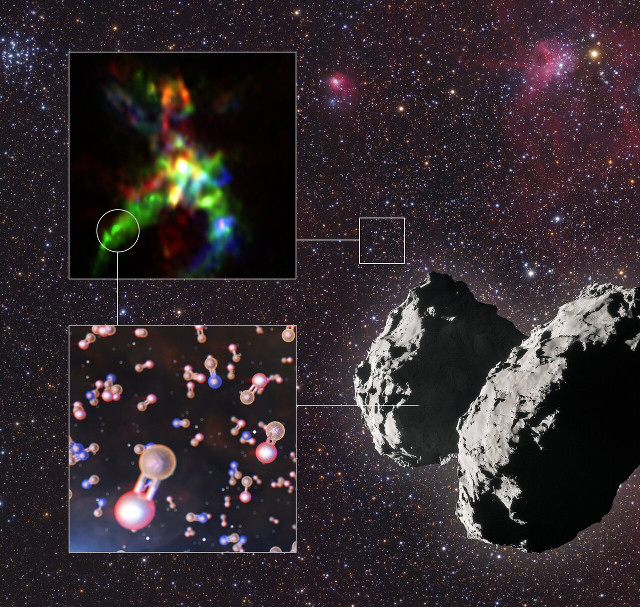
An article to be published in the journal “Monthly Notices of the Royal Astronomical Society” reports a study tracing the journey of phosphorus from star formation to comets. A team of researchers led by Víctor Rivilla of the Italian National Institute of Astrophysics used the ALMA radio telescope and data collected by ESA’s Rosetta space probe’s ROSINA instrument on comet 67P/Churyumov–Gerasimenko to understand where phosphorus is formed and how comets may have brought it to Earth, where it’s needed by life forms.
The mission of the Rosetta space probe ended on September 30, 2016, but the wealth of data collected will continue to be useful for many years. The ROSINA (Rosetta Orbiter Spectrometer for Ion and Neutral Analysis) instrument collected a lot of data including those about phosphorus but that’s only a part of the research, in the sense that scientists are unable to say where that element comes from.
To understand the origin of phosphorus-containing molecules, the researchers used the ALMA (Atacama Large Millimeter / Submillimeter Array) radio telescope, inaugurated in March 2013. This very powerful and sensitive instrument allowed to study a star formation region cataloged as AFGL 5142, where they found traces of molecules such as phosphorus monoxide.
When massive stars form, gas flow dig cavities in the interstellar clouds in which they formed. Molecules containing phosphorus are formed on the walls of those cavities due to shock waves and radiation emitted by those stars. The observations conducted with the ALMA radio telescope made it possible to establish that phosphorus monoxide is the most abundant of the molecules containing phosphorus on the walls of the cavities.
Those molecules can end up in a protoplanetary disk surrounding a star in its formation stage. If they remain far enough from the star, they can be incorporated in grains of icy dust that gradually come together and a part ends up in the comets. This reconstruction was confirmed by putting together the data collected by the ALMA radio telescope and the Rosetta space probe’s ROSINA instrument. It’s important because comets have probably brought many chemical compounds to Earth and phosphorus monoxide could be among those, providing an element needed for life forms.
The image (ALMA (ESO/NAOJ/NRAO), Rivilla et al.; ESO/L. Calçada; ESA/Rosetta/NAVCAM; Mario Weigand, www.SkyTrip.de) shows a composition that includes the key elements of this research. In the background there’s an area of the sky in the constellation of Auriga where there’s the star formation region AFGL 5142, shown in the top box. There, phosphorus monoxide molecules were detected by ALMA, shown in the bottom box and also detected on the comet 67P/Churyumov–Gerasimenko, shown on the right side.
Astronomer Leonardo Testi of ESO, one of the authors of this research, stressed the importance of the synergy between world leading ground-based and space facilities. The ALMA radio telescope and the Rosetta space probe are very different instruments and this research confirms the importance of collaborations that, precisely by exploiting those differences, allow to obtain a complete picture, in this case from a star formation region and from a comet.
This research shows how a ingredient needed by life on Earth may have been brought to the planet by comets such as 67P/Churyumov–Gerasimenko after being generated in distant stars. In this specific case, the element is phosphorus, but many clues suggest that other elements and even organic molecules discovered in comets also arrived on the primordial Earth that way, contributing to making it fertile.


Permalink